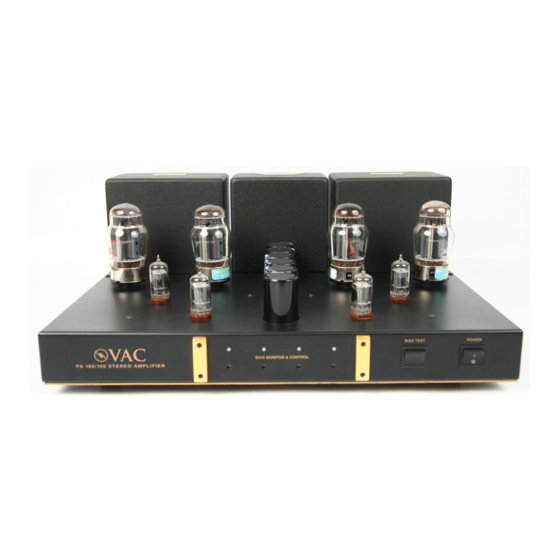Advertisement
Quick Links
VAC PA100/100 POWER AMPLIFIER
Operating Instructions
DO NOT OPEN THIS UNIT - NO USER SERVICEABLE PARTS INSIDE. DO NOT
REMOVE THE BOTTOM PLATE. LETHAL VOLTAGES ARE PRESENT WITHIN
THE CHASSIS. DO NOT EXPOSE TO MOISTURE OR OPERATE IT IF WET.
VACUUM TUBES BECOME HOT ENOUGH TO CAUSE SERIOUS BURNS. NEVER
TOUCH A TUBE WHEN THE UNIT IS ON. IT MAY TAKE SEVERAL MINUTES
FOR THE TUBES TO COOL DOWN AFTER THE UNIT IS SWITCHED OFF.
DO NOT PLUG INTO AC UNTIL ALL CONNECTIONS ARE COMPLETED.
Introduction
The VAC PA100/100 is a single chassis wide-band low-feedback stereo
amplifier conservatively rated at 100 watts per channel. It is to be operated only
from the voltage visible on the configuration card located under the fuse. Please
contact VAC or your dealer if the voltage in your area does not agree with the
label. The fuse is a slow blow type of the size noted on the back of the chassis.
A tube cage is available as an option.
The input circuit of the PA100/100 is derivative of the Williamson design, which
was first published in England in 1947, and was the mainstay of the original
high fidelity movement. Notable features of this circuit include a direct-coupled
input amplifier and phase splitter, resulting in low phase shift, and inherent
precise balance of the phase splitter (if properly executed) at all frequencies and
levels, resulting in excellent push-pull balance, stability, and low distortion
The output stage is derived from the renowned PA90C, featuring individually
adjustable "fixed-bias" and partial-triode ("ultra-linear") operation.
Premium parts are employed throughout, including 14 pound 22 section bifilar-
wound ultra-wideband output transformers, polypropylene and polystyrene
signal capacitors, high current rectifiers, low ESR power supply, and
proprietary wiring. The quality of parts and careful layout allows the use of very
little feedback for high sonic purity and low distortion.
Advertisement

Summary of Contents for VAC VAC PA100/100
- Page 1 DO NOT PLUG INTO AC UNTIL ALL CONNECTIONS ARE COMPLETED. Introduction The VAC PA100/100 is a single chassis wide-band low-feedback stereo amplifier conservatively rated at 100 watts per channel. It is to be operated only from the voltage visible on the configuration card located under the fuse. Please contact VAC or your dealer if the voltage in your area does not agree with the label.
- Page 2 Unpacking Each tube socket on the amplifier is covered by a small round sticker. The color of this sticker corresponds to the color of the sticker on a tube. Fit each tube into the matching socket, first removing the sticker from the tube and socket.
- Page 3 Operation Continuous operation is not recommended. If the amplifiers will not be auditioned for a few hours it is best to turn them off. This avoids undue stress to the KT88 output tubes. As with all high fidelity products, the sound characteristics of the VAC amplifiers change somewhat as they warm up.
- Page 4 Installing New Output Tubes Replacement tubes are available from VAC and other sources. Output tubes are KT88 beam power Kinkless Tetrodes (6550 may also be used - see Tips & Advice, Output Tubes). It is not necessary that they be matched pairs, although a slight improvement in measured performance may be achieved in this way.
- Page 5 Care of Chassis & Face Plate VAC chassis are aluminum for superior electromagnetic performance. The finish is a tough textured powder coat paint. This finish is durable but can be scratched or chipped, just as that of a fine automobile may be damaged.
-
Page 6: Registration Form
__________________________________ Salesperson ____________________ Dealer address _________________________________________________________________ Purchase date ___________________________ How did you first learn of VAC products? __________________________________________ Please provide any comments on VAC products or your dealer _________________________ ______________________________________________________________________________ ______________________________________________________________________________ ______________________________________________________________________________ ______________________________________________________________________________ REGISTRATION FORM VAC PA100/100 Serial Number___________________ www.vac-amps.com info@vac-amps.com... - Page 7 Tips & Advice A Word About Tubes in General It is a truth that each brand of tube sounds different in a particular high resolution circuit. This is because no two manufacturers make a tube type in quite the same way, and the central tendencies of the performance parameters will differ slightly with each maker.
- Page 8 TIPS & ADVICE A Word About Output Tubes Your VAC Amplifier can use 2 different output tube types: the KT88 Beam Power Kinkless Tetrode and the 6550A Beam Power Tetrode. We consider the sound of a good KT88 to be superior. Properly manufactured 6550/6550A will work, but may have a slightly higher incidence of failure in the PA100/100.
- Page 9 Germany." Tubes actually manufactured by RCA, Westinghouse, and Sylvania can be quite good, but the name on the tube doesn't always indicate who actually made it. Other names to watch for are Valvo, Mazda, Tung-Sol, Bendix, Mullard, Brimar, and Raytheon.
- Page 10 TIPS & ADVICE A Word About Impedance Matching We strongly suggest that you experiment with the three available impedance connections for the best sonic match with your system. Since no loudspeaker represents an unchanging impedance at all frequencies, it is impossible to assert with certainty which output tap is appropriate to use.
-
Page 11: Specifications
SPECIFICATIONS The VAC System has been developed with the critical ear as the major arbiter of quality, with both conventional and unique measurements providing insight and guidance as necessary. The lack of emphasis on measurements is due to the fact that engineering's arsenal of equipment and techniques do not operate on the pattern recognition principles that control human perception of sound.












Need help?
Do you have a question about the VAC PA100/100 and is the answer not in the manual?
Questions and answers